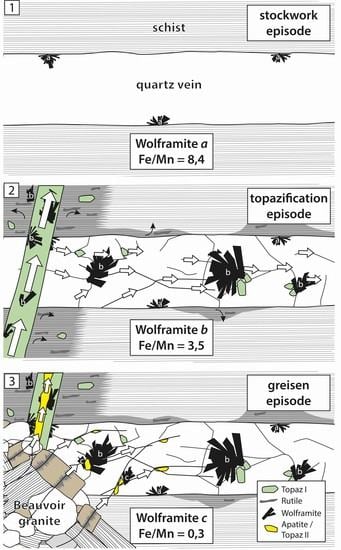Multiple Generations of Wolframite Mineralization in the Echassieres District (Massif Central, France)
Abstract
1. Introduction
2. Geological Setting
3. Materials and Methods
3.1. Sampling and Microscopic Investigations
3.2. Microprobe Analysis
3.3. Laser Ablation-Inductively Coupled Plasma-Mass Spectrometry (LA-ICP-MS) Analysis
4. Petrography
4.1. Beauvoir and Colettes Granites
4.2. La Bosse Stockwork Area
4.2.1. Quartz Veins
4.2.2. Topaz Veins
4.2.3. Schist Host Rock
4.3. Proximal Veins
5. Mineral Chemistry
5.1. Wolframite
5.2. Goethite
5.3. Topaz
6. Discussion
6.1. Paragenesis and Relative Chronology
6.1.1. Stockwork Episode
6.1.2. Topazification Episode
6.1.3. Greisen Episode
6.1.4. Kaolinization Episode
6.2. Source, Reservoir and Remobilization of W
6.3. Comparison with the Literature
6.4. Evolution of Fe/Mn Ratio for the Different Types of Wolframite
7. Conclusions
Supplementary Materials
Author Contributions
Funding
Acknowledgments
Conflicts of Interest
References
- European Commission. Report on Critical Raw Materials for the EU, 2014; European Commission: Brussels, Belgium, 2014; pp. 1–92. [Google Scholar]
- European Commission. Study on the Review of the List of Critical Raw Materials, 2017; European Commission: Brussels, Belgium, 2017; pp. 1–92. [Google Scholar] [CrossRef]
- Brown, T.; Pitfield, P. Tungsten. In Critical Metals Handbook; Gun, G., Ed.; Wiley: Hoboken, NJ, USA, 2013; pp. 385–413. [Google Scholar]
- Mlynarczyk, M.S.J.; Williams-Jones, A.E. The role of collisional tectonics in the metallogeny of the central Andean tin belt. Earth Planet Sci. Lett. 2005, 240, 656–667. [Google Scholar] [CrossRef]
- Dewaele, S.; De Clercq, F.; Hulsbosch, N.; Piessens, K.; Boyce, A.; Burgess, R.; Muchez, P. Genesis of the vein-type tungsten mineralization at Nyakabingo (Rwanda) in the Karagwe–Ankole belt, Central Africa. Miner. Depos. 2016, 51, 283–307. [Google Scholar] [CrossRef]
- Zhao, W.W.; Zhou, M.F.; Li, Y.H.M.; Zhao, Z.; Gao, J.F. Genetic types, mineralization styles, and geodynamic settings of Mesozoic tungsten deposits in South China. J. Asian Earth Sci. 2017, 137, 109–140. [Google Scholar] [CrossRef]
- Harlaux, M.; Romer, R.L.; Mercadier, J.; Morlot, C.; Marignac, C.; Cuney, M. 40 Ma of hydrothermal W mineralization during the Variscan orogenic evolution of the French Massif Central revealed by U-Pb dating of wolframite. Miner. Depos. 2017, 53, 21–51. [Google Scholar] [CrossRef]
- Pirajno, F. (Ed.) Intrusion-Related hydrothermal mineral systems. In Hydrothermal Processes and Mineral Systems; Springer Science & Business Media: Berlin, Germany, 2008; pp. 205–354. [Google Scholar]
- Marignac, C. Geologic, fluid inclusions, and stable isotope studies of the tin-tungsten deposits of Panasqueira, Portugal: Discussion. Econ. Geol. 1982, 77, 1263–1266. [Google Scholar] [CrossRef]
- Polya, D.A.; Foxford, K.A.; Stuart, F.; Boyce, A.; Fallick, A.E. Evolution and paragenetic context of low δD hydrothermal fluids from the Panasqueira W-Sn deposit, Portugal: New evidence from microthermometric, stable isotope, noble gas and halogen analyses of primary fluid inclusions. Geochim. Cosmochim. Acta 2000, 64, 3357–3371. [Google Scholar] [CrossRef]
- Burnard, P.G.; Polya, D.A. Importance of mantle derived fluids during granite associated hydrothermal circulation: He and Ar isotopes of ore minerals from Panasqueira. Geochim. Cosmochim. Acta 2004, 68, 1607–1615. [Google Scholar] [CrossRef]
- Chicharro, E.; Boiron, M.C.; López-García, J.Á.; Barfod, D.N.; Villaseca, C. Origin, ore forming fluid evolution and timing of the Logrosán Sn–(W) ore deposits (Central Iberian Zone, Spain). Ore Geol. Rev. 2016, 72, 896–913. [Google Scholar] [CrossRef]
- Carocci, E.; Marignac, C.; Cathelineau, M.; Truche, L.; Lecomte, A.; Pinto, F. Rutile from Panasqueira (Central Portugal): An excellent pathfinder for wolframite deposition. Minerals 2019, 1, 9. [Google Scholar] [CrossRef]
- Breiter, K.; Förster, H.J.; Seltmann, R. Variscan silicic magmatism and related tin-tungsten mineralization in the Erzgebirge-Slavkovský les metallogenic province. Miner. Depos. 1999, 34, 505–521. [Google Scholar] [CrossRef]
- Lecumberri-Sanchez, P.; Vieira, R.; Heinrich, C.A.; Pinto, F.; Wӓlle, M. Fluid-rock interaction is decisive for the formation of tungsten deposits. Geology 2017, 45, 579–582. [Google Scholar] [CrossRef]
- Mao, Z.; Cheng, Y.; Liu, J.; Yuan, S.; Wu, S.; Xiang, X.; Luo, X. Geology and molybdenite Re–Os age of the Dahutang granite-related veinlets-disseminated tungsten ore field in the Jiangxin Province, China. Ore Geol. Rev. 2013, 53, 422–433. [Google Scholar] [CrossRef]
- Xie, L.; Wang, R.C.; Che, X.D.; Huang, F.F.; Erdmann, S.; Zhang, W.L. Tracking magmatic and hydrothermal Nb–Ta–W–Sn fractionation using mineral textures and composition: A case study from the late Cretaceous Jiepailing ore district in the Nanling Range in South China. Ore Geol. Rev. 2016, 78, 300–321. [Google Scholar] [CrossRef]
- Zhou, J.; Feng, C.; Li, D.; Li, G. Geological, geochemical, and geochronological characteristics of Caledonian W–Sn mineralization in the Baiganhu orefield, southeastern Xinjiang, China. Ore Geol. Rev. 2016, 75, 125–149. [Google Scholar] [CrossRef]
- Zhang, Y.; Gao, J.F.; Ma, D.; Pan, J. The role of hydrothermal alteration in tungsten mineralization at the Dahutang tungsten deposit, South China. Ore Geol. Rev. 2018, 95, 1008–1027. [Google Scholar] [CrossRef]
- Jackson, N.J.; Willis-Richards, J.; Manning, D.A.; Sams, M.S. Evolution of the Cornubian ore field, Southwest England; Part II, Mineral deposits and ore-forming processes. Econ. Geol. 1989, 84, 1101–1133. [Google Scholar] [CrossRef]
- Chesley, J.T.; Halliday, A.N.; Snee, L.W.; Mezger, K.; Shepherd, T.J.; Scrivener, R.C. Thermochronology of the Cornubian batholith in southwest England: Implications for pluton emplacement and protracted hydrothermal mineralization. Geochim. Cosmochim. Acta 1993, 57, 1817–1835. [Google Scholar] [CrossRef]
- Williamson, B.J.; Stanley, C.J.; Wilkinson, J.J. Implications from inclusions in topaz for greisenisation and mineralization in the Hensbarrow topaz granite, Cornwall, England. Contrib. Miner. Petrol. 1997, 127, 119–128. [Google Scholar] [CrossRef]
- Aubert, G. Les Coupoles Granitiques de Montebras et d’Echassières (Massif Central Français) et la Genèse de Leur Minéralisation en Étain, Lithium, Tungsten et Béryllium; B.R.G.M. Mémoires: Paris, France, 1969; p. 345. [Google Scholar]
- Monnier, L.; Lach, P.; Salvi, S.; Melleton, J.; Bailly, L.; Beziat, D.; Monnier, Y.; Gouy, S. Quartz trace-element composition by LA-ICP-MS as proxy for granite differentiation, hydrothermal episodes, and related mineralization: The beauvoir granite (Echassières district), France. Lithos 2018, 320, 355–377. [Google Scholar] [CrossRef]
- Cuney, M.; Marignac, C.; Weisbrod, A. The Beauvoir topaz-lepidolite albite granite (Massif Central, France); the disseminated magmatic Sn-Li-Ta-Nb-Be mineralization. Econ. Geol. 1992, 87, 1766–1794. [Google Scholar] [CrossRef]
- Duthou, J.L.; Pin, C. Etude isotopique Rb/Sr de l’apex granitique d’Echassières. Géol. Fr. 1987, 2, 63–67. [Google Scholar]
- Raimbault, L.; Cuney, M.; Azencott, C.; Duthou, J.L.; Joron, J.L. Geochemical evidence for a multistage magmatic genesis of Ta-Sn-Li mineralization in the granite at Beauvoir, French Massif Central. Econ. Geol. 1995, 90, 548–576. [Google Scholar] [CrossRef]
- Merceron, T.; Vieillard, P.; Fouillac, A.M.; Meunier, A. Hydrothermal alterations in the Echassieres granitic cupola (Massif Central, France). Contrib. Miner. Petrol. 1992, 112, 279–292. [Google Scholar] [CrossRef]
- Cheilletz, A.; Archibald, D.A.; Cuney, M.; Charoy, B. Ages 40Ar/39Ar du leucogranite à topaze-lépidolite de Beauvoir et des pegmatites sodolithiques de Chédeville (Nord du Massif Central, France). Signification pétrologique et géodynamique. C. R. Acad. Sci. 1992, 315, 329–336. [Google Scholar]
- Pin, C. Sr-Nd isotopic study of igneous and metasedimentary enclaves in some Hercynian granitoids from the Massif Central, France. Dev. Petrol. 1991, 13, 333–343. [Google Scholar]
- Rossi, P.; Autran, A.; Azencott, C.; Burnol, L.; Cuney, M.; Johan, V.; Raimbault, L. Logs pétrographiques et géochimiques du granite de Beauvoir dans le sondage GPF “Echassières I”: Minéralogie et géochimie comparée. Géol. Fr. 1987, 2, 111–135. [Google Scholar]
- Ledru, P.; Lardeaux, J.M.; Santallier, D.; Autran, A.; Quenardel, J.M.; Floc’h, J.P.; Ploquin, A. Où sont les nappes dans le Massif central français? Bull. Soc. Géol. Fr. 1989, 3, 605–618. [Google Scholar] [CrossRef]
- Faure, M.; Mézème, E.B.; Duguet, M.; Cartier, C.; Talbot, J.Y. Paleozoic tectonic evolution of medio-Europa from the example of the French Massif Central and Massif Armoricain. J. Virt. Expl. 2005, 19, 1–25. [Google Scholar] [CrossRef]
- Schulz, B.; Triboulet, C.; Audren, C.; Feybesse, J.L. PT-paths from metapelite garnet zonations, and crustal stacking in the Variscan inverted metamorphic sequence of La Sioule, French Massif Central. Z. Dtsch. Geol. Ges. 2001, 152, 1–26. [Google Scholar]
- Schulz, B. EMP-monazite age controls on PT paths of garnet metapelites in the Variscan inverted metamorphic sequence of La Sioule, French Massif Central. Bull. Soc. Géol. Fr. 2009, 180, 271–282. [Google Scholar] [CrossRef]
- Do Couto, D.; Faure, M.; Augier, R.; Cocherie, A.; Rossi, P.; Li, X.H.; Lin, W. Monazite U–Th–Pb EPMA and zircon U–Pb SIMS chronological constraints on the tectonic, metamorphic, and thermal events in the inner part of the Variscan orogen, example from the Sioule series, French Massif Central. Int. J. Earth Sci. 2016, 105, 557–579. [Google Scholar] [CrossRef]
- Melleton, J.; Gloaguen, E.; Frei, D. Rare-Elements (Li–Be–Ta–Sn–Nb) Magmatism in the European Variscan Belt: A Review. In Proceedings of the 13th Biennial SGA Meeting, Nancy, France, 24–27 August 2015; pp. 24–27. [Google Scholar]
- Pearce, N.J.; Perkins, W.T.; Westgate, J.A.; Gorton, M.P.; Jackson, S.E.; Neal, C.R.; Chenery, S.P. A compilation of new and published major and trace element data for NIST SRM 610 and NIST SRM 612 glass reference materials. Geostand. Geoanal. Res. 1997, 21, 115–144. [Google Scholar] [CrossRef]
- Wang, R.C.; Fontan, F.; Monchoux, P. Minéraux disséminés comme indicateurs du caractère pegmatitique du granite de Beauvoir, Massif d’Echassières, Allier, France. Can. Mineral 1992, 30, 763–770. [Google Scholar]
- Harlaux, M.; Mercadier, J.; Marignac, C.; Peiffert, C.; Cloquet, C.; Cuney, M. Tracing metal sources in peribatholitic hydrothermal W deposits based on the chemical composition of wolframite: The example of the Variscan French Massif Central. Chem. Geol. 2018, 479, 58–85. [Google Scholar] [CrossRef]
- Tarassov, M.; Mihailova, B.; Tarassova, E.; Konstantinov, L. Chemical composition and vibrational spectra of tungsten-bearing goethite and hematite from Western Rhodopes, Bulgaria. Eur. J. Mineral 2002, 14, 977–986. [Google Scholar] [CrossRef]
- Kreissl, S.; Bolanz, R.; Göttlicher, J.; Steininger, R.; Tarassov, M.; Markl, G. Structural incorporation of W6+ into hematite and goethite: A combined study of natural and synthetic iron oxides developed from precursor ferrihydrite and the preservation of ancient fluid compositions in hematite. Am. Minerol. 2016, 101, 2701–2715. [Google Scholar] [CrossRef]
- Launay, G.; Sizaret, S.; Guillou-Frottier, L.; Gloaguen, E.; Pinto, F. Deciphering fluid flow at the magmatic-hydrothermal transition: A case study from the world-class Panasqueira W–Sn–(Cu) ore deposit (Portugal). Earth Planet Sci. Let. 2018, 499, 1–12. [Google Scholar] [CrossRef]
- Fouillac, A.M.; Rossi, P. Near-solidus delta 18 O depletion in a Ta-Nb-bearing albite granite; the Beauvoir Granite, France. Econ. Geol 1991, 86, 1704–1720. [Google Scholar] [CrossRef]
- Launay, G.; Sizaret, S.; Guillou-Frottier, L.; Fauguerolles, C.; Champallier, R.; Gloaguen, E. Dynamic permeability related to greisenization reactions in Sn-W ore deposits: Quantitative petrophysical and experimental evidence. Geofluids 2019. [Google Scholar] [CrossRef]
- Webster, J.; Thomas, R.; Förster, H.J.; Seltmann, R.; Tappen, C. Geochemical evolution of halogen-enriched granite magmas and mineralizing fluids of the Zinnwald tin-tungsten mining district, Erzgebirge, Germany. Miner. Depos. 2004, 39, 452–472. [Google Scholar] [CrossRef]
- Thomas, R.; Förster, H.J.; Rickers, K.; Webster, J.D. Formation of extremely F-rich hydrous melt fractions and hydrothermal fluids during differentiation of highly evolved tin-granite magmas: A melt/fluid-inclusion study. Contrib. Miner. Petrol. 2005, 148, 582–601. [Google Scholar] [CrossRef]
- Aïssa, M.; Marignac, C.; Weisbrod, A. Le stockwerk à ferbérite d’Echassières: Évolution spatiale et temporelle; cristallochimie des ferbérites. Géol. Fr. 1987, 2, 311–333. [Google Scholar]
- Moncada, D.; Mutchler, S.; Nieto, A.; Reynolds, T.J.; Rimstidt, J.D.; Bodnar, R.J. Mineral textures and fluid inclusion petrography of the epithermal Ag–Au deposits at Guanajuato, Mexico: Application to exploration. J. Geochem. Explor. 2012, 114, 20–35. [Google Scholar] [CrossRef]
- Davis, W.J.; Williams-Jones, A.E. A fluid inclusion study of the porphyry-greisen, tungsten-molybdenum deposit at Mount Pleasant, New Brunswick, Canada. Miner. Depos. 1985, 20, 94–101. [Google Scholar] [CrossRef]
- Wood, S.A.; Samson, I.M. The hydrothermal geochemistry of tungsten in granitoid environments: I. Relative solubilities of ferberite and scheelite as a function of T, P, pH, and m NaCl. Econ. Geol. 2000, 95, 143–182. [Google Scholar] [CrossRef]
- Bowen, N.L. The Evolution of the Igneous Rocks; Dover Publications: Mineola, NY, USA, 1956. [Google Scholar]
- Michaud, J.A.S.; Pichavant, M. The H/F ratio as an indicator of contrasted wolframite deposition mechanisms. Ore Geol. Rev. 2019, 104, 266–272. [Google Scholar] [CrossRef]
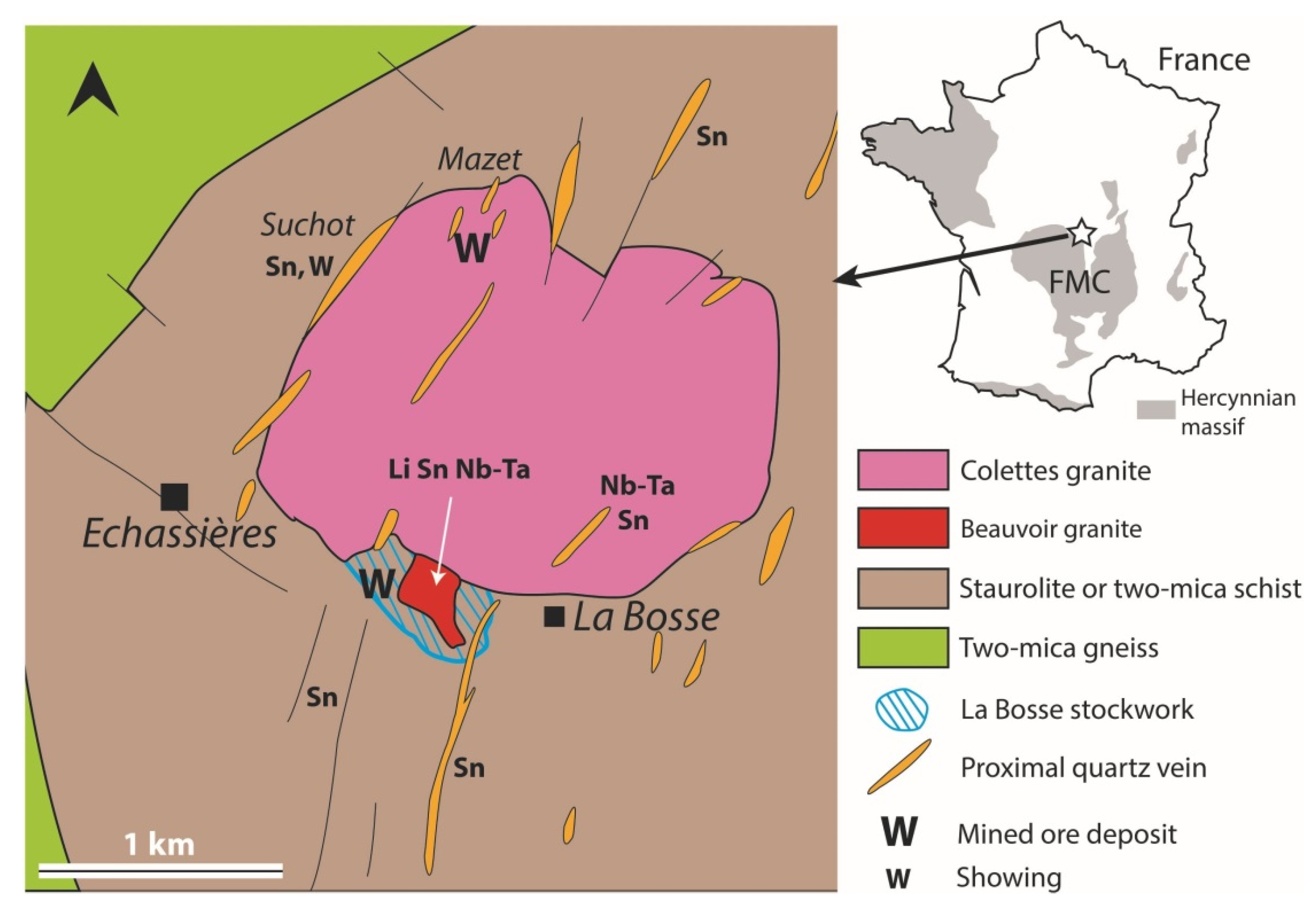
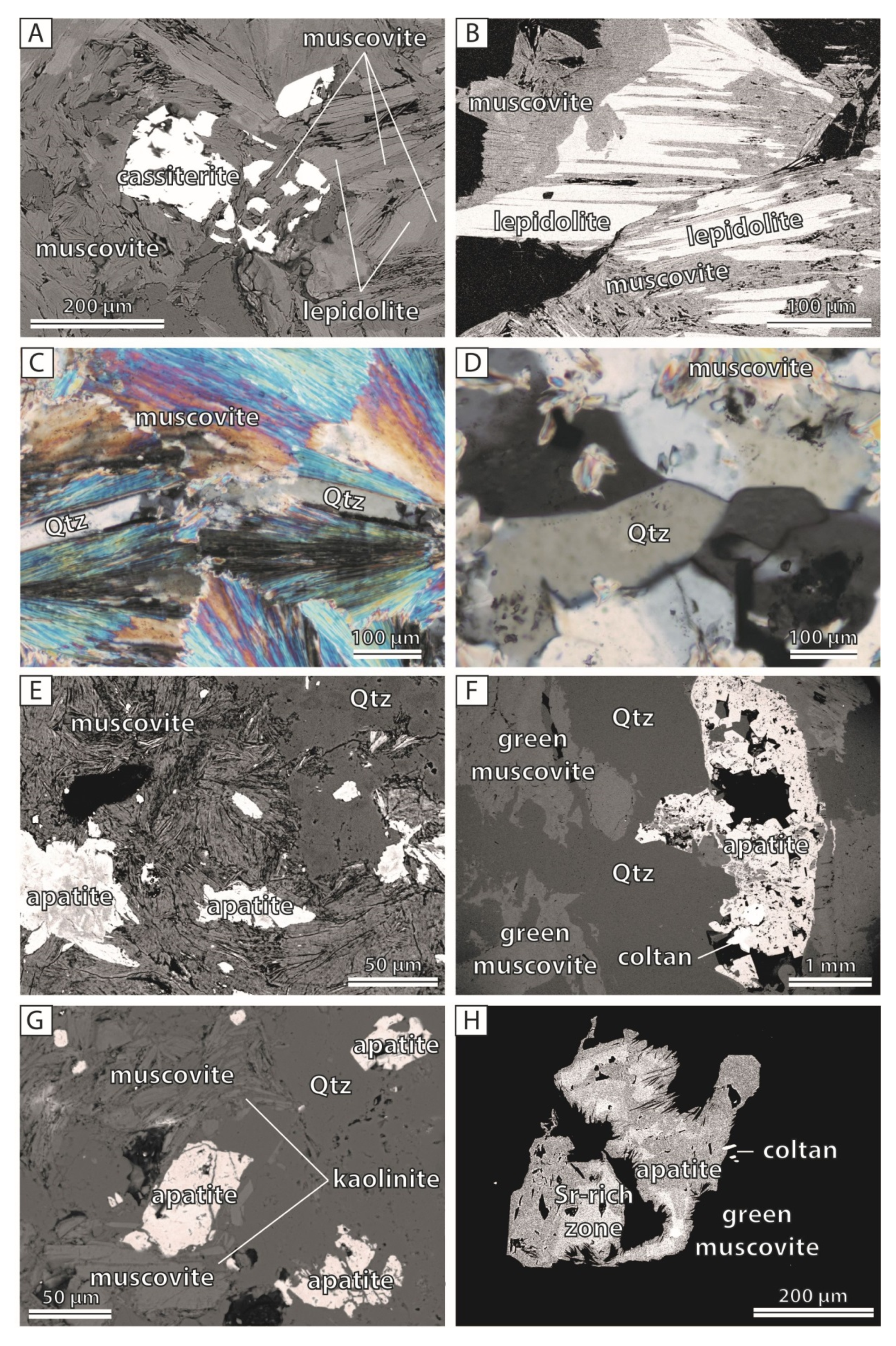
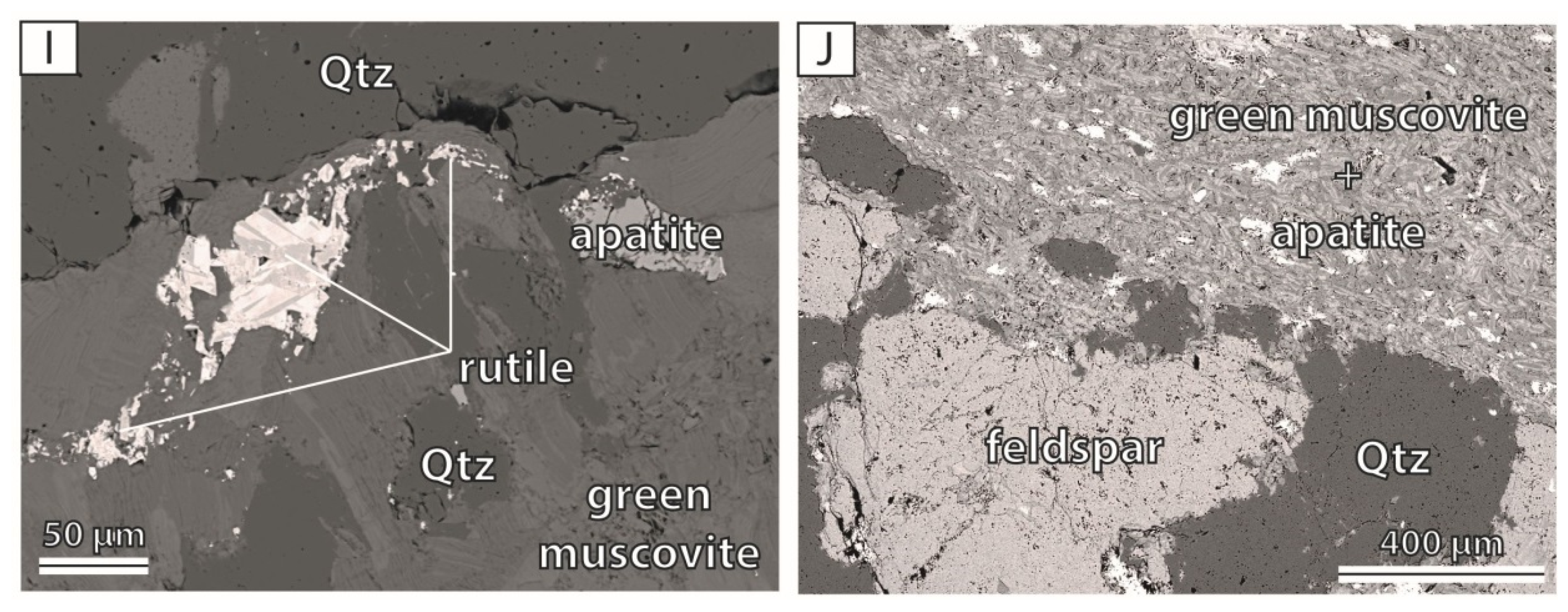
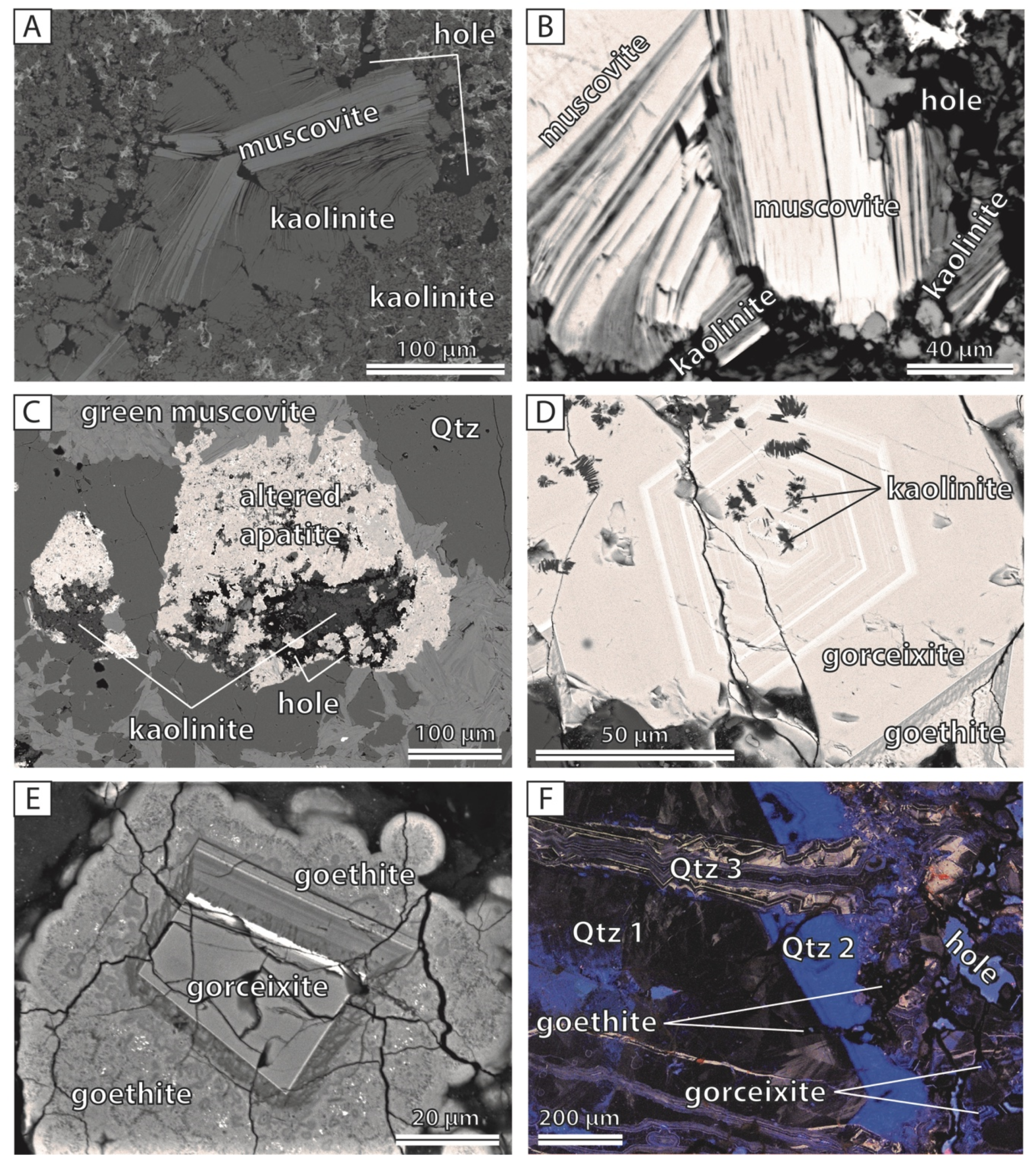
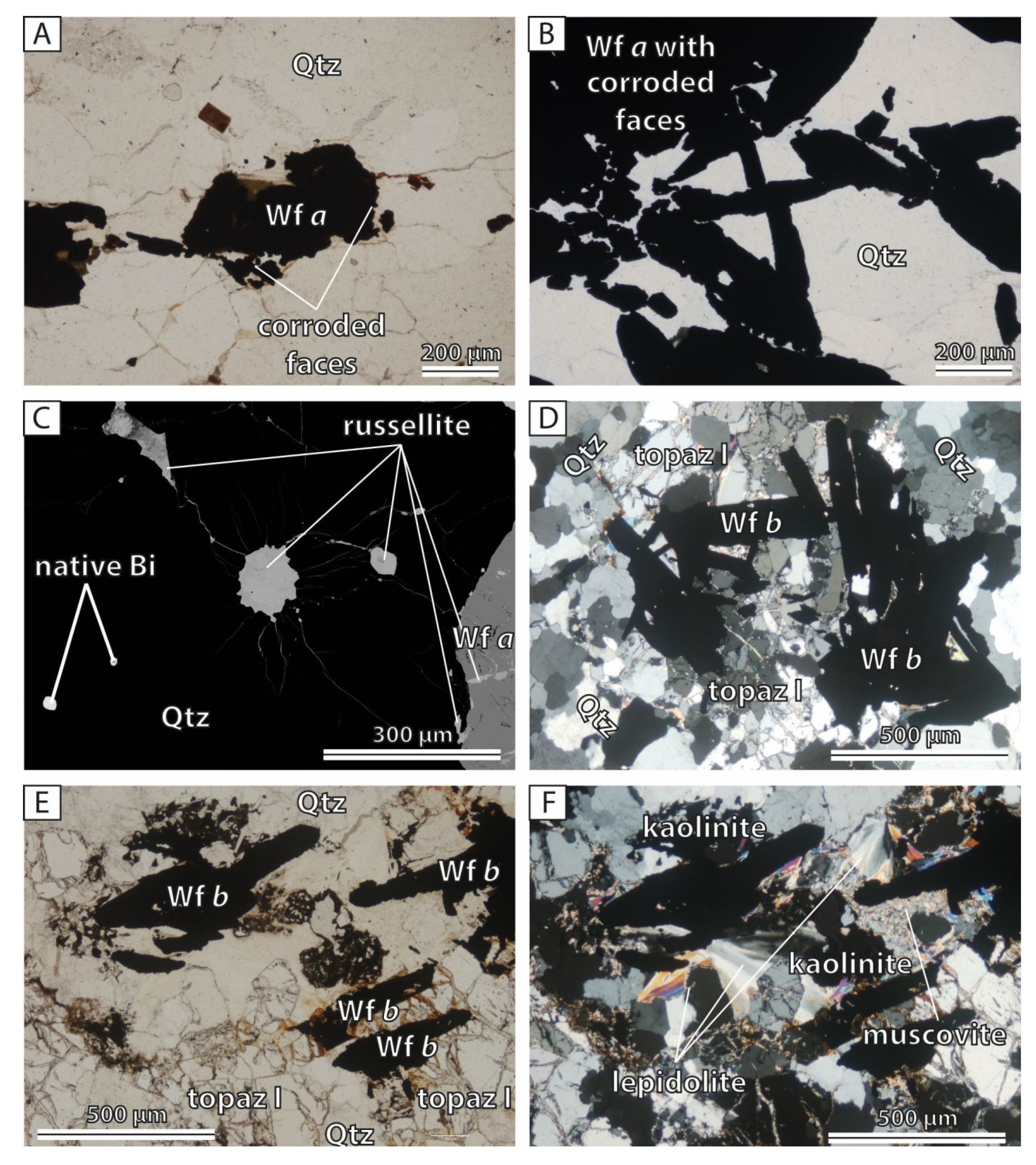
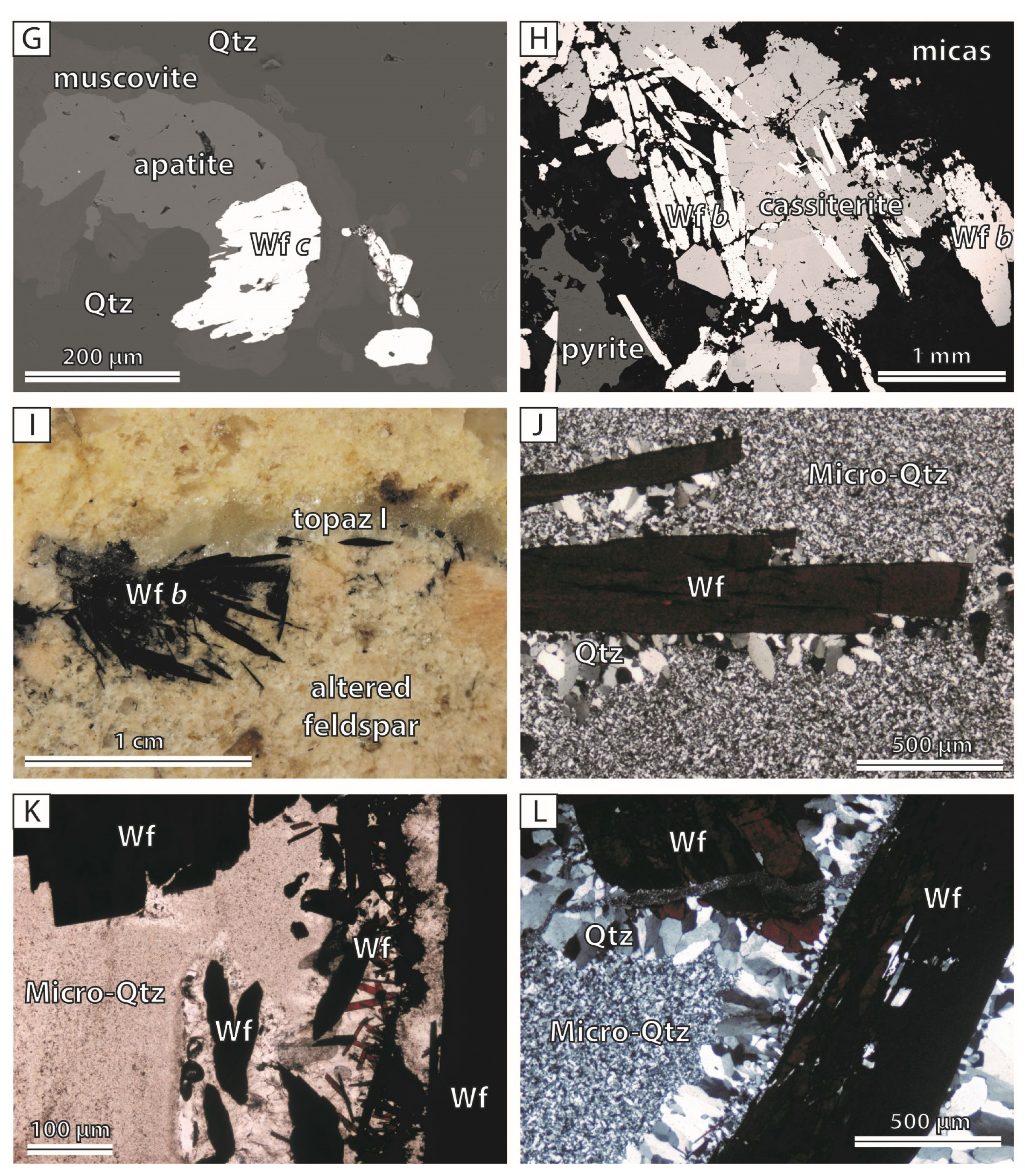
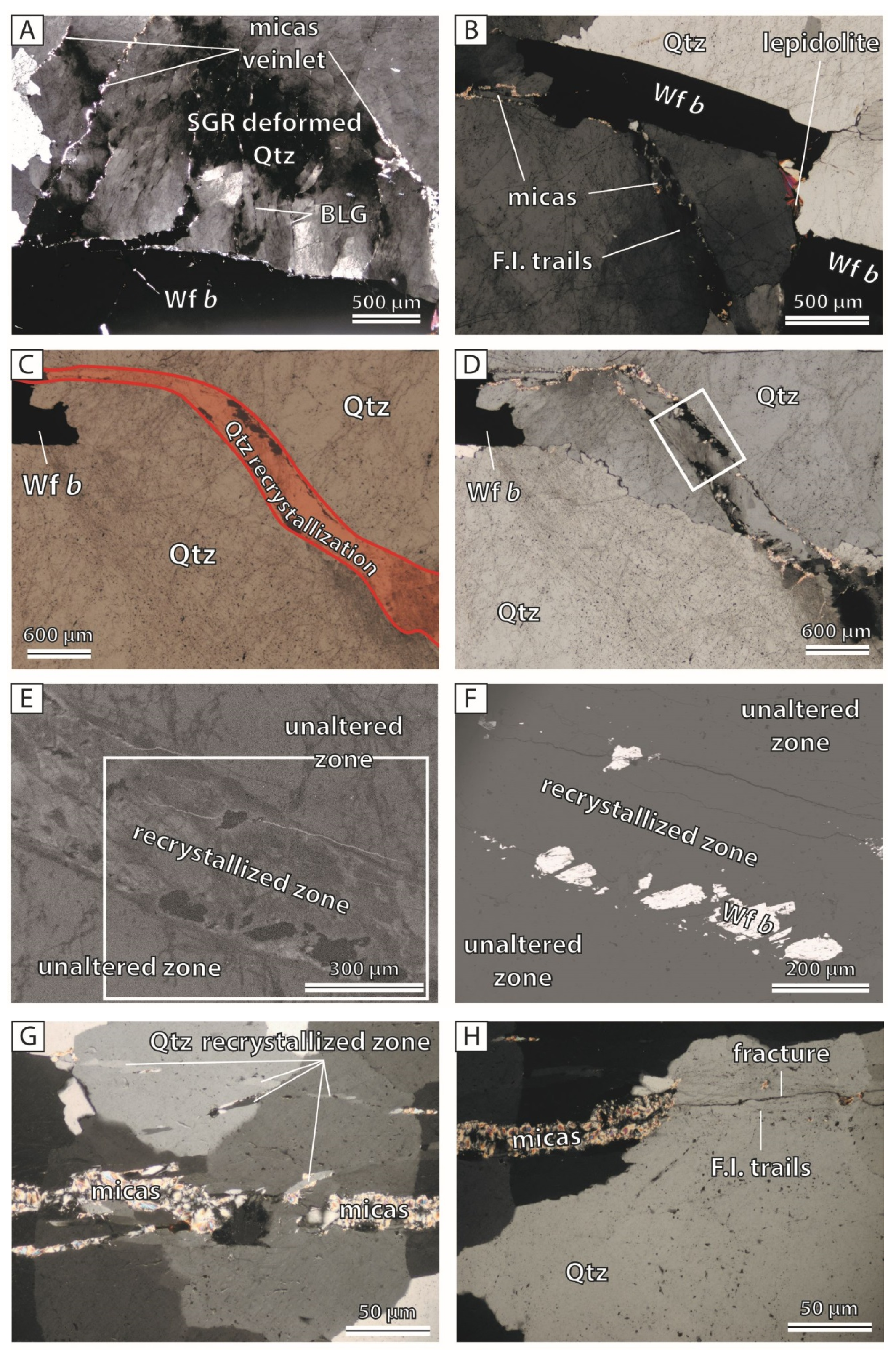
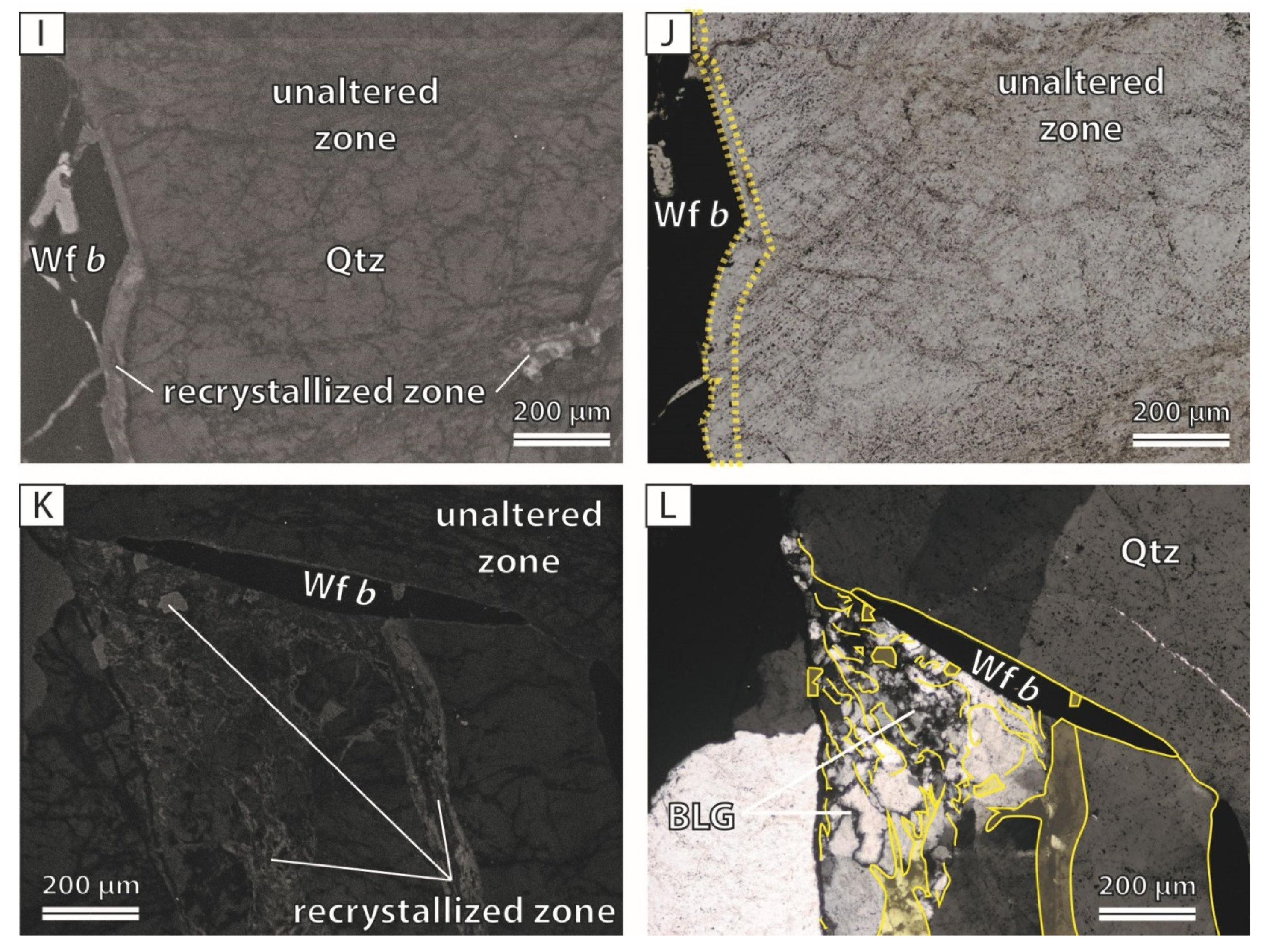
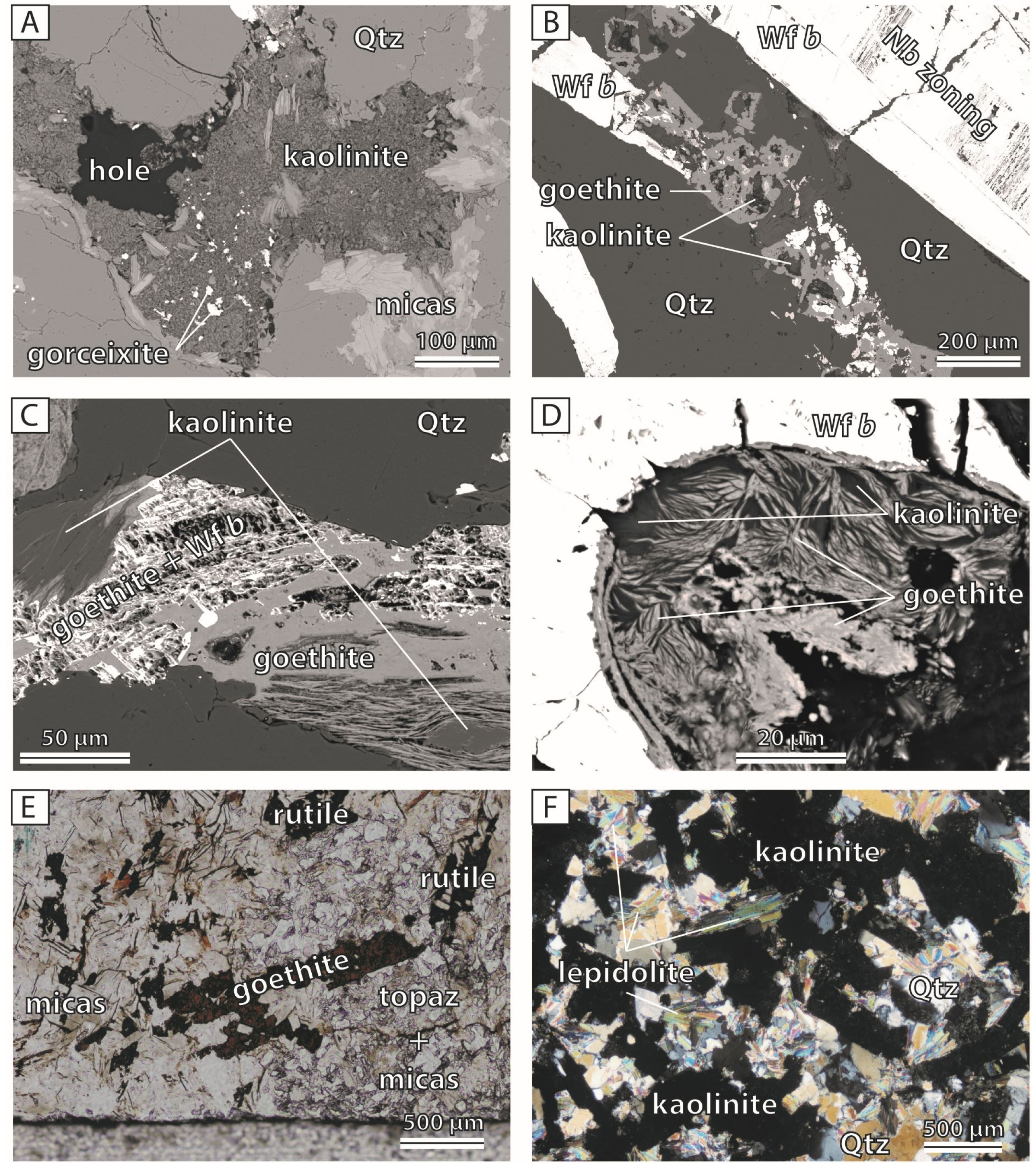
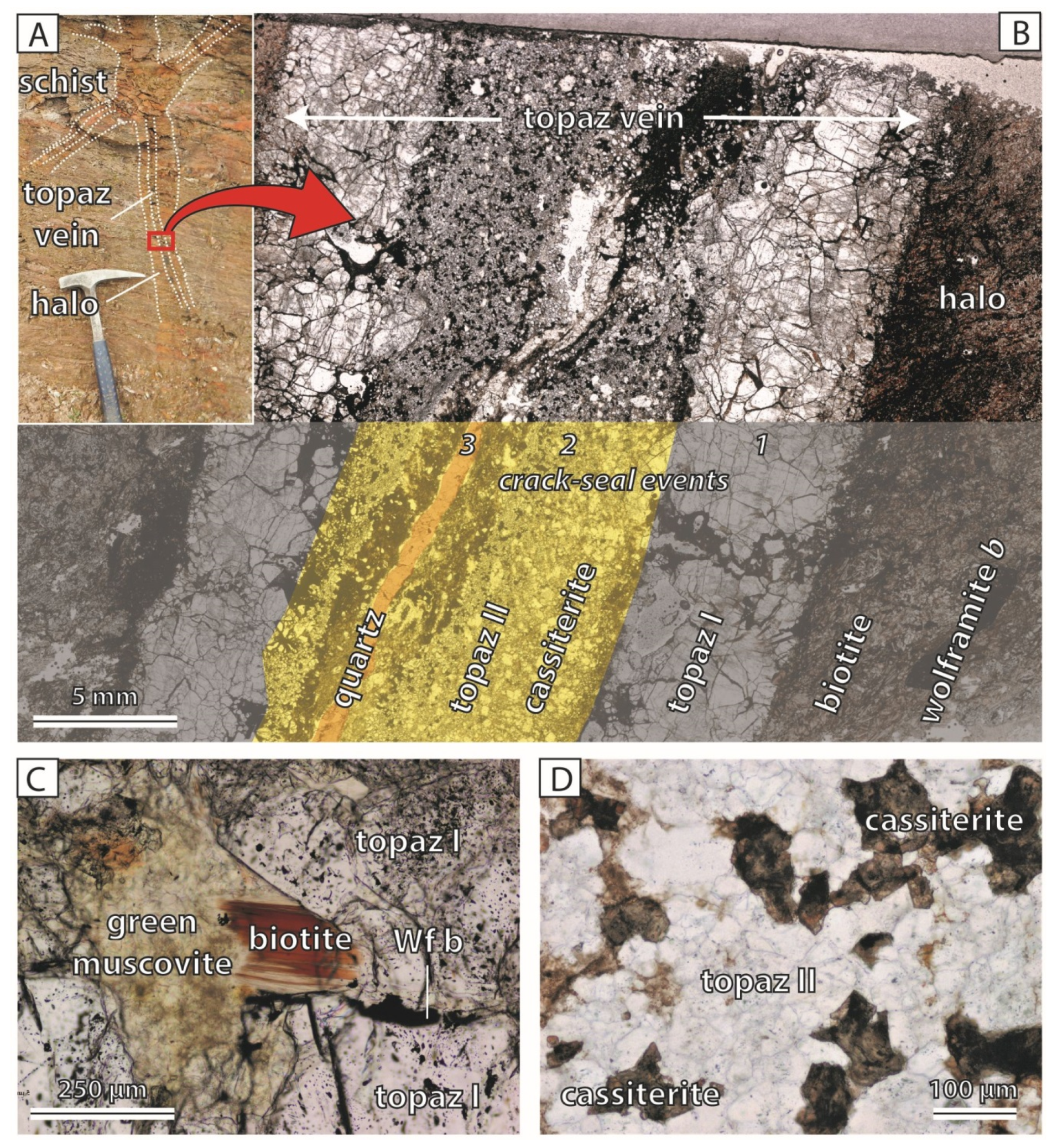
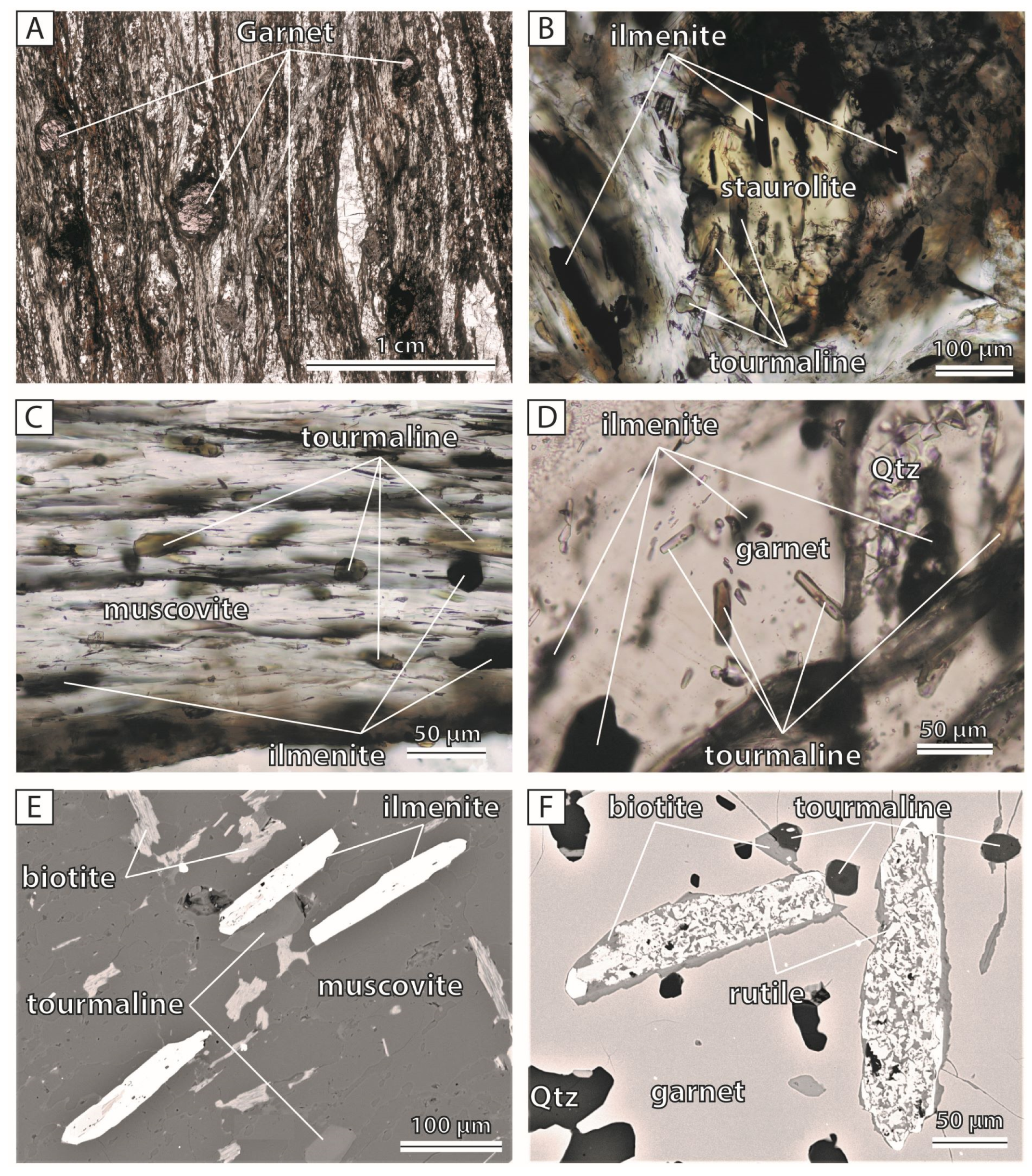
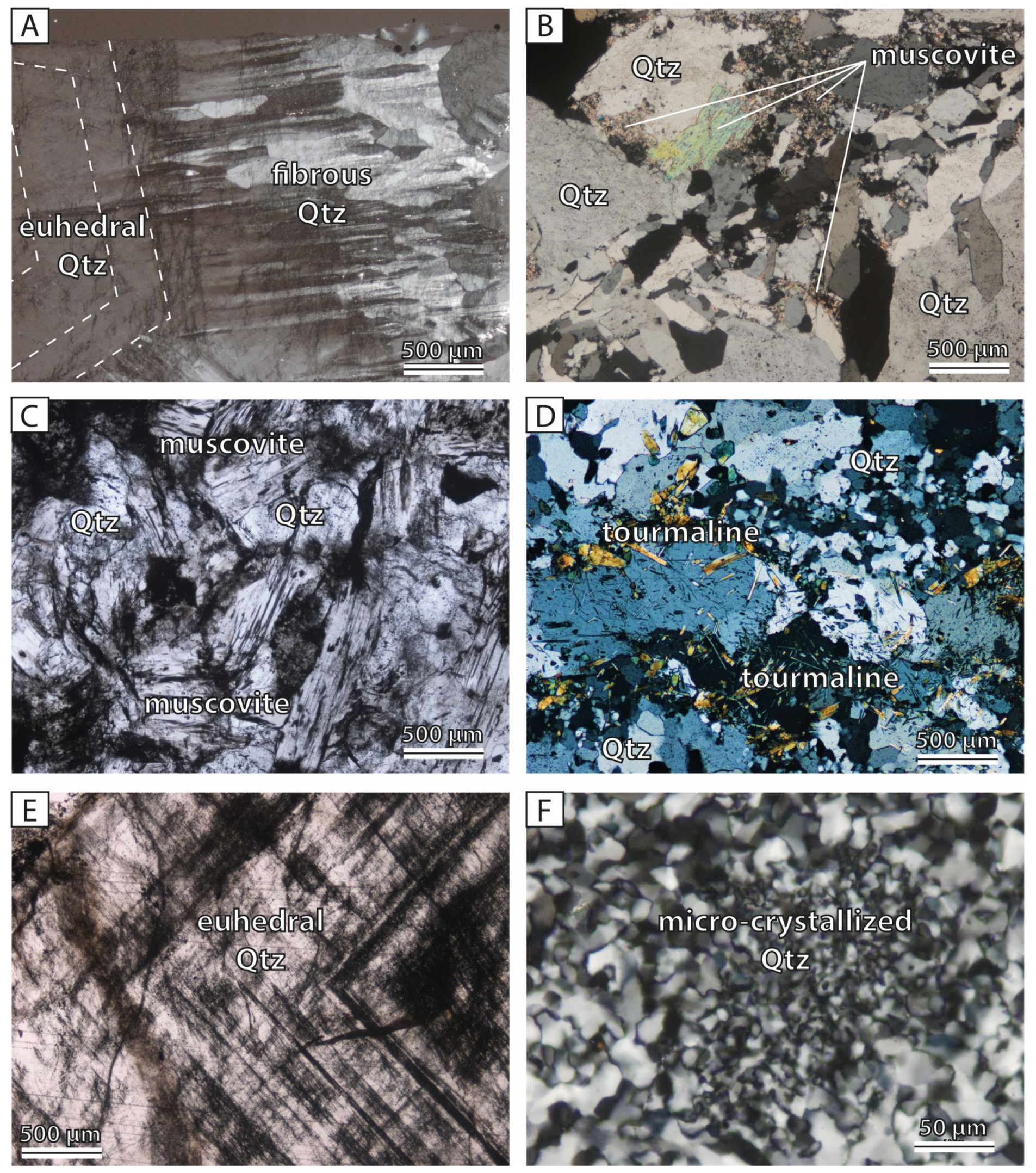
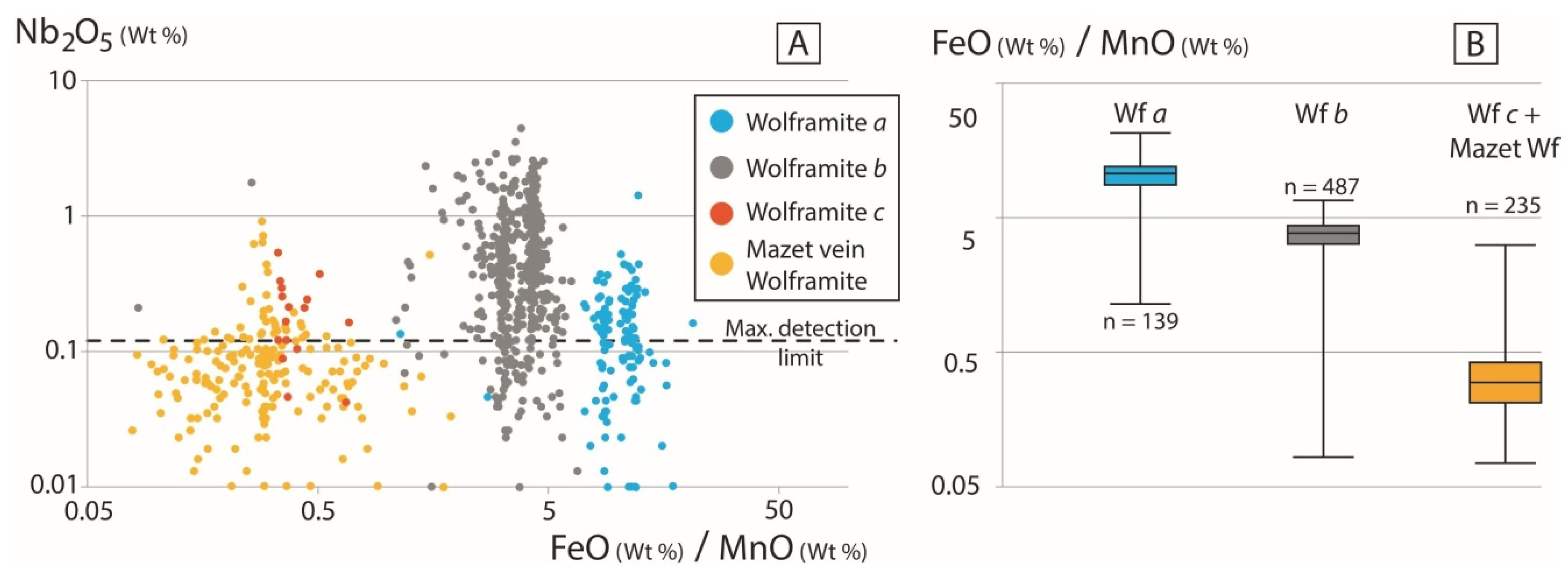
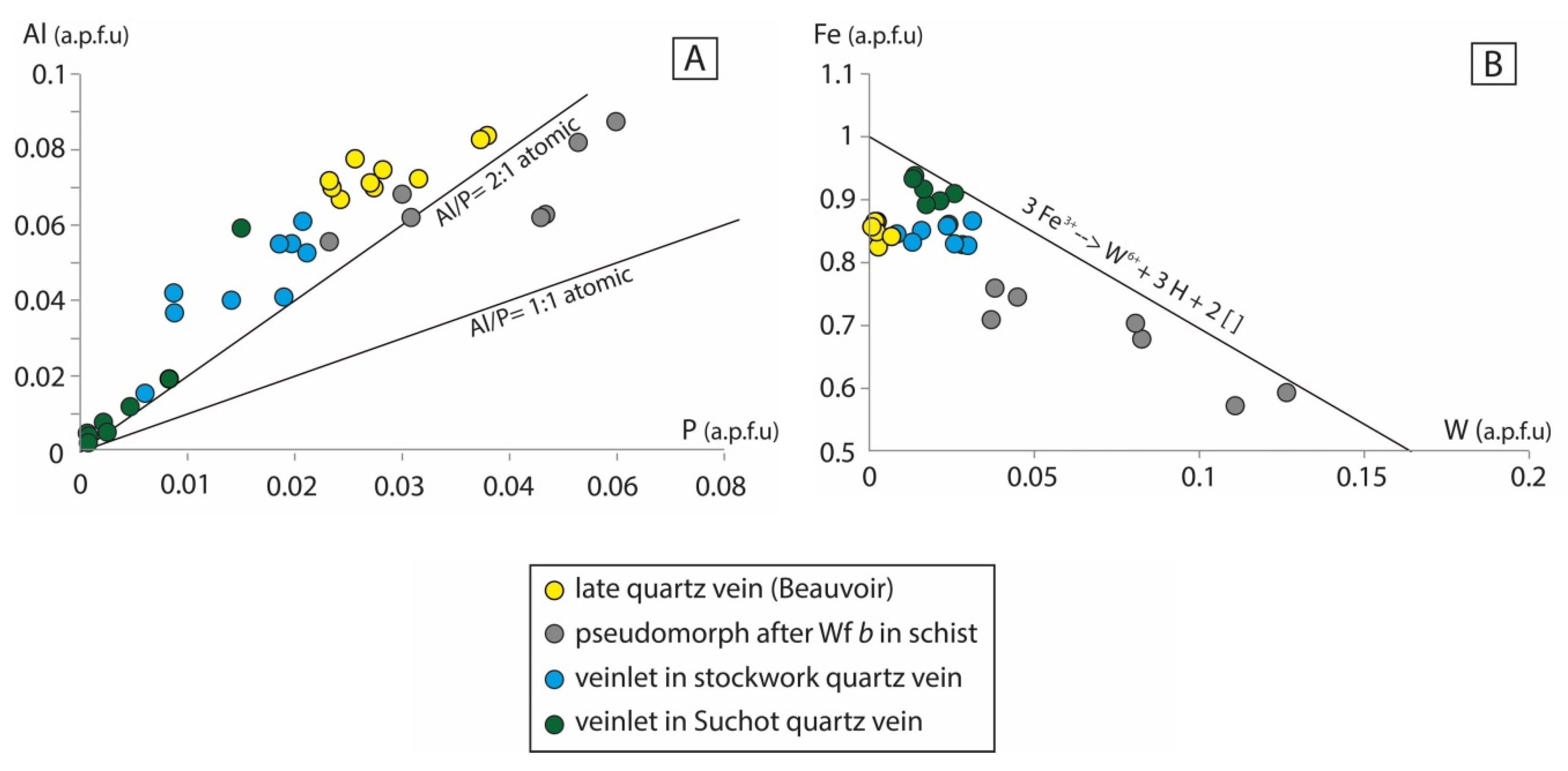
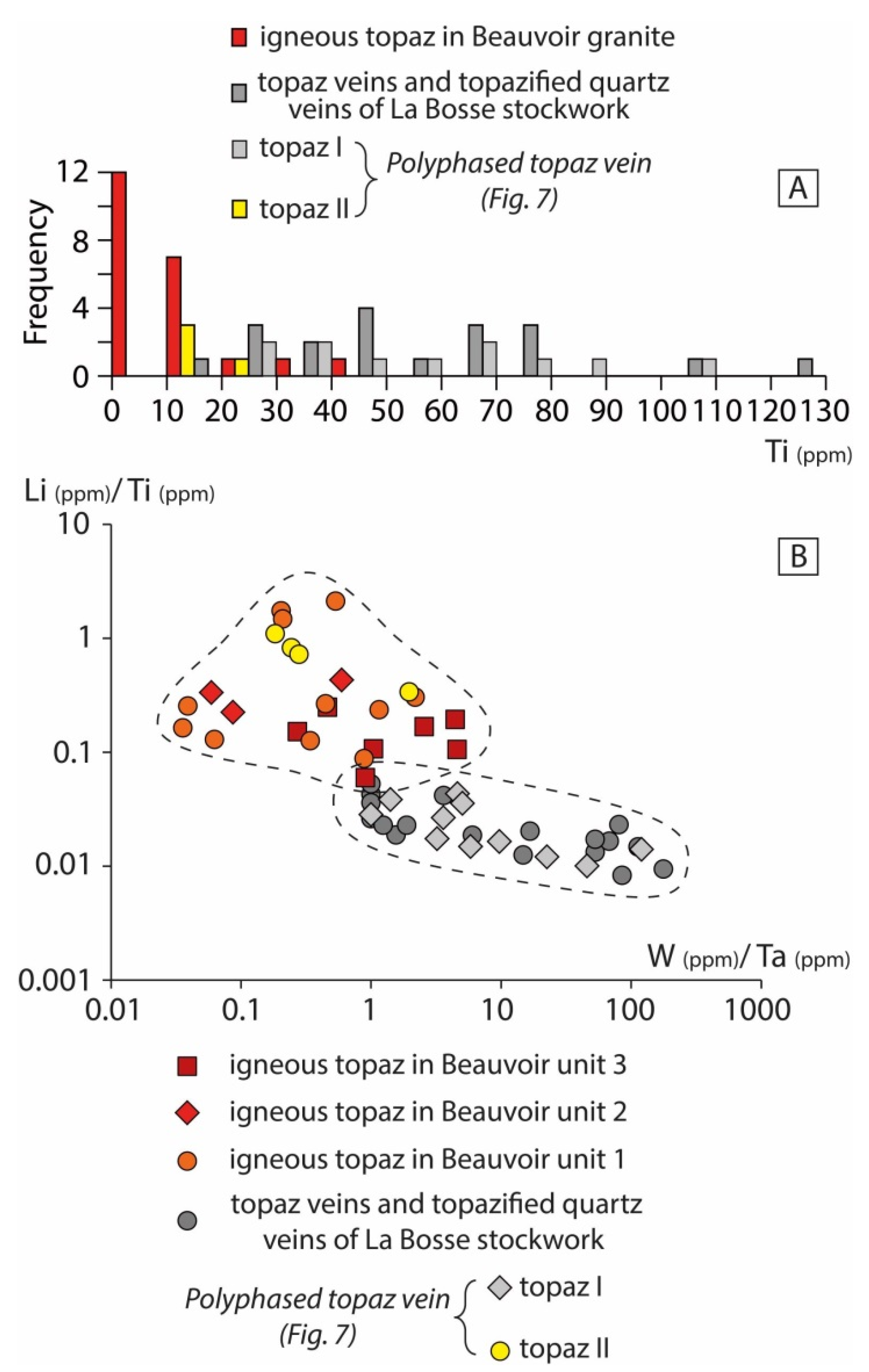
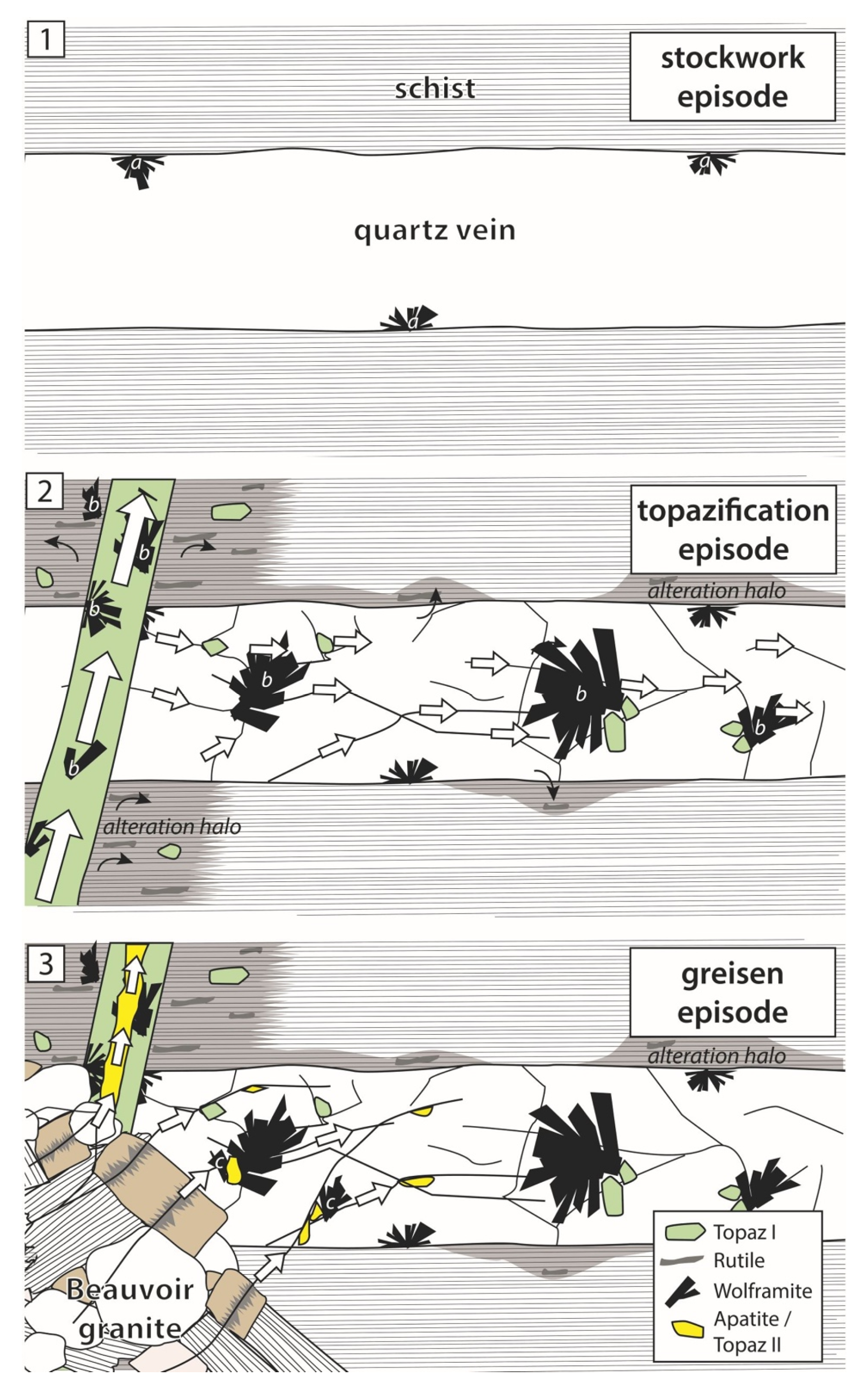
| Laser | |
|---|---|
| Type | CETAC Excite |
| Wavelength | 193 nm |
| Laser frequency | 8 Hz |
| Fluence | 7 J·cm−2 |
| Ablation spot size | 85 µm |
| ICP-MS | |
| Model | X series II |
| Type | Quadrupole |
| ICP RF Power | 1400 W |
| Cooling gas (Ar) | 13 to 14 L·min−1 |
| Carrier gas (He) | 0.15 to 0.3 L·min−1 |
| Auxiliary gas (Ar) | 1 L·min−1 |
| Acquisition Parameters | |
| Measured isotopes | 7Li, 9Be, 11B, 23Na, 27Al, 29Si, 47Ti, 72Ge, 85Rb, 88Sr, 93Nb, 118Sn, 121Sb, 181Ta, 182W |
| Dwell time per mass | 30 ms |
| Background | 20 s |
| Acquisition time | 40 s (320 pulses) |
| Background collection | 20 s |
| Wash-out delay | 20 s |
| Data Reduction | |
| Software | Glitter® |
| Standard | NIST SRM 612 [38] |
| Mineralization Type | Location | Principal Accompanying Minerals |
|---|---|---|
| Wolframite a | Quartz vein of La Bosse stockwork. | quartz, tourmaline, ilmenite, bismuth metal. |
| Wolframite b |
| topaz I, lepidolite/F-biotite series, rutile. |
| Wolframite c |
| quartz, apatite, muscovite, topaz II. |
| W-rich goethite | Small quantities in all altered rocks of Echassières district:
| kaolinite, quartz, gorceixite, Mn-oxide. |
| Estimated Proportions of Wolframite Types in Different Localities | ||||
|---|---|---|---|---|
| Generation | Stockwork Above Beauvoir Granite | Stockwork Below Beauvoir Granite | Mazet Veins | Echassières District (Total) |
| Wolframite a | 5% | 20% | 0% | ca. 10% |
| Wolframite b | 95% | 80% | 0% | ca. 80% |
| Wolframite c | <1% | 0% | 100% | ca. 10% |
© 2019 by the authors. Licensee MDPI, Basel, Switzerland. This article is an open access article distributed under the terms and conditions of the Creative Commons Attribution (CC BY) license (http://creativecommons.org/licenses/by/4.0/).
Share and Cite
Monnier, L.; Salvi, S.; Melleton, J.; Bailly, L.; Béziat, D.; de Parseval, P.; Gouy, S.; Lach, P. Multiple Generations of Wolframite Mineralization in the Echassieres District (Massif Central, France). Minerals 2019, 9, 637. https://doi.org/10.3390/min9100637
Monnier L, Salvi S, Melleton J, Bailly L, Béziat D, de Parseval P, Gouy S, Lach P. Multiple Generations of Wolframite Mineralization in the Echassieres District (Massif Central, France). Minerals. 2019; 9(10):637. https://doi.org/10.3390/min9100637
Chicago/Turabian StyleMonnier, Loïs, Stefano Salvi, Jérémie Melleton, Laurent Bailly, Didier Béziat, Philippe de Parseval, Sophie Gouy, and Philippe Lach. 2019. "Multiple Generations of Wolframite Mineralization in the Echassieres District (Massif Central, France)" Minerals 9, no. 10: 637. https://doi.org/10.3390/min9100637
APA StyleMonnier, L., Salvi, S., Melleton, J., Bailly, L., Béziat, D., de Parseval, P., Gouy, S., & Lach, P. (2019). Multiple Generations of Wolframite Mineralization in the Echassieres District (Massif Central, France). Minerals, 9(10), 637. https://doi.org/10.3390/min9100637







